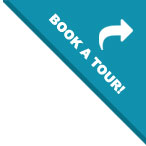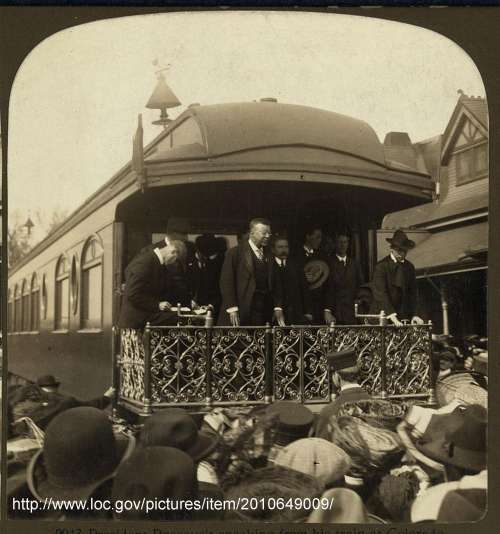


Last month, the TR Site had the pleasure of welcoming award-winning author Chris Epting to its ongoing Speaker Nite series. He began his remarks by explaining his passion for finding the places where history actually happened. This has led him to seek out the subway grate where Marilyn Monroe filmed that scene in The Seven Year Itch, the field in New Jersey where the Hindenberg met its fiery end, and many other places where familiar events took place.
Epting’s interest in places of historical import was obvious as he spoke about his recent book, Teddy Roosevelt in California: The Whistle Stop Tour that Changed America. In Epting’s estimation, TR’s 1903 trip to the West Coast was one of the most important presidential trips ever. The 14,000-mile journey began in April, took TR through twenty-five states, and lasted nine weeks. It took place almost two years into his presidency and a little more than a year before the 1904 election. In this sense, the trip can be seen as an opportunity to appeal to western voters. However, TR was equally determined to arrange a face-to-face meeting with John Muir, the nation’s leading naturalist and conservation advocate. To that end, TR essentially wrote Muir a fan letter in March of 1903, the text of which Epting shared with the audience:
“…I wish to write you personally to express the hope that you will be able to take me through the Yosemite. I do not want anyone with me but you, and I want to drop politics absolutely for four days and just be out in the open with you. John Burroughs is probably going through the Yellowstone Park with me, and I want to go with you through the Yosemite.”
Muir was scheduled to go to Europe and, according to Epting, wasn’t going to change his plans until an astute friend pointed out that a meeting of this kind with the President of the United States was not an opportunity to waste!
Roosevelt traveled by train and was not joined by his wife or children. His private car – the Elysian – was not only equipped with” two sleeping chambers, two bathrooms, a private kitchen, a dining room, [and] a stateroom with pictures windows”, but also a rear platform from which he delivered countless speeches. However, TR did not just give speeches from the train. He helped shovel coal and enjoyed visiting with the train’s engineers; he also liked to blow the train’s whistle in the middle of the night!
Epting revealed that the Roosevelt family’s pet badger was a souvenir from TR’s 1903 cross-country adventure. The story goes that, while in Kansas, a young girl asked TR if he would be interested in having a baby badger her brother had recently caught. When Roosevelt agreed, the girl retrieved the badger and presented it to the president. It was named ‘Josiah’ after the girl’s brother and rode back to Washington on the train, cared for by the president himself as well as members of the press.
TR’s route included stops at both Yellowstone and the Grand Canyon. At Yellowstone, Roosevelt famously dedicated the imposingarch that bears his name. While showing the audience a photo of the dedication ceremony, Epting asked us to consider how different speeches were before the advent of microphone technology. Crowds had to be extremely quiet if they wanted to hear the speaker, who -- in turn -- had to project his voice in an effort to reach the assembled multitude. Imagine the toll this must have taken on TR’s voice, giving speech after speech under those circumstances.
On his way to Yosemite, TR stopped in Santa Cruz to see some of California’s famous redwood trees for himself. He was not entirely pleased when he discovered those trees covered with calling cards and advertising posters. His anger was reflected in his speech that day:
“…the rash creature who wishes to leave his name to mar the beauties of nature should be sternly discouraged. Take those cards pinned up on that tree; they give an air of the ridiculous to this solemn and majestic grove. To pin those cards up there is as much out of place as if you tacked so many tin cans up there. I mean that literally. You should save the people whose names are there from the reprobation of every individual by taking down the cards at the earliest possible moment; and do keep these trees, keep all of the wonderful scenery of this wonderful State unmarred by vandalism or the folly of man. Remember that we have to contend not merely with knavery, but with folly; and see to it that by your actions create the kind of public opinion which will put a stop to any destruction of or any marring of the wonderful and beautiful gifts that you have received from nature…”
After his speech, TR went for a brief walk in a nearby grove. By the time he got back, all of the offending calling cards and posters had been removed!
Roosevelt finally met John Muir for the first time on May 15th, 1903. The meeting took place on a train in the small town of Raymond, California, which was the closest station to Yosemite. From there, the men traveled about 35-40 miles (about 8 hours) by stagecoach, which gave them their first opportunity to get acquainted. They stopped in Mariposa Grove, where TR saw his first sequoia and (like any tourist) had his picture taken driving through the “Tunnel Tree.” It was then time for his real adventure to begin.
President Roosevelt dismissed his aides and the press; he spent the next three days “roughing it” with John Muir and two guides. The plan, according to Epting, left TR’s advisors more than a little uneasy -- especially since snow was in the forecast. Nonetheless, the group of four men headed off into Yosemite’s splendor. The first night was spent under the awe-inspiring sequoias, with TR and Muir still getting to know one another. By the second night, which was spent at the edge of the canyon walls near Glacier Point, the two men were ready to get down to business. Epting described a long conversation by the campfire, with Muir making a strong case for the preservation of forests and other natural resources (some suggest that this conversation solidified TR’s support for the 1906 Antiquities Act). It was not all serious business around the campfire, however. Epting recounted how Muir set fire to a downed tree that evening and proceeded to dance a jig alongside it; he was soon joined by the president! Later that night, the predicted snowstorm came to fruition.
One of Roosevelt’s final stops in Yosemite was the studio of landscape painter Thomas Hill. While there, TR admired a painting that -- coincidentally -- depicted the meadows near Bridalveil Fall, where he had spent the last night of his trip with John Muir. It is well-known that the artist made a gift of the painting to the president, but Epting left the audience with a story about how his research uncovered a long-forgotten secret. Several sources indicate that the painting was simply removed from the wall and traveled back to Washington with TR. However, Epting came across a letter in which TR thanked Hill for “having sent me the picture [emphasis added]” -- which didn’t make sense and led Epting back to the newspaper archives. There, he found a tantalizing note that explained, “Mr. Hill proposed to paint the president in the foreground, just where he camped, and then send the canvas to Washington.” So, it seems that the small figure in the foreground of the painting is actually Theodore Roosevelt, purposefully put there by an artist commemorating the president’s time in Yosemite.
(Postscript: Having discovered that the figure in the painting is TR, Chris Epting is currently making the case that the painting should be placed in the Roosevelt Room of the White House.)
-- Lenora M. Henson, Curator / Director of Public Programming
*****
Speaker Nite is part of the TR Site’s regular Tuesday evening programming, which is made possible with support from M&T Bank.

The Theodore Roosevelt Inaugural National Historic Site is operated by the Theodore Roosevelt Inaugural Site Foundation, a registered non-profit organization, through a cooperative agreement with the National Park Service.
© 2025 | All Rights Reserved
641 Delaware Avenue, Buffalo, NY 14202 • (716) 884-0095
Website by Luminus
